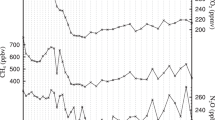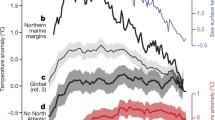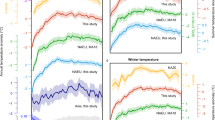Abstract
We propose a new approach for comparing mid-Holocene climates from 18 PMIP simulations with climate reconstructions of winter and growing season temperatures and the annual water budget inferred from European pollen and lake-level data. A cluster analysis is used to extract patterns of multivariate climate response from the reconstructions; these are then compared to the patterns simulated by models. According to paleodata, summers during mid-Holocene were warmer-than-present in the north, and cooler-than-present in the south, while winters were colder-than-present in the southwest but milder-than-present in the northeast. Whereas warmer summers and colder winters may easily be explained as a direct response to the amplified seasonal cycle of insolation during the mid-Holocene, the other recorded responses are less straightforward to explain. We have identified, from the models that correctly simulate the recorded climate change, two important atmospheric and hydrological processes that can compensate for direct insolation effects. First, a stronger-than-present airflow from southwestern Europe that veers to the north over Eastern Europe, in winter, can consistently explain the reconstructed changes in this season’s temperatures and water budget. Second, the increased winter soil moisture allows a shift of the partitioning of net radiative energy towards latent rather than sensible heat fluxes, thereby decreasing surface temperature during the following summer season. Our approach therefore solves one of the recurring problems in model-data comparisons that arises when a model simulates the correct response but in the wrong location (as a consequence, for instance, of model resolution and topography).










Similar content being viewed by others
References
Bartlein PJ, Anderson KH, Anderson PM, Edwards ME, Mock CJ, Thompson RS, Webb RS, Webb III T, Whitlock C (1998) Paleoclimate simulations for North America over the past 21,000 years: features of the simulated climate and comparisons with paleoenvironmental data. Quat Sci Rev 17: 549–585
Berger A (1978) Long-term variations of daily insolation and quaternary climatic changes. J Atmos Sci 35: 2362–2367
Bonan GB (1998) The land surface climatology of the NCAR Land Surface Model coupled to the NCAR Community Climate Model. J Clim 11: 1307–1326
Bonfils C (2001) Paleoclimate modelling: impact of the representation of the surface on the climate sensitivity. Ph.D Thesis, University Pierre et Marie Curie, France
Bonfils C, Lewden D, Taylor KE (1998) A summary documentation of the PMIP models, PCMDI Report. http://www-lsce.cea.fr/pmip
Bonfils C, de Noblet-Ducoudré N, Braconnot P, Joussaume S (2001) Hot desert albedo and climate change: Mid-Holocene monsoon in North Africa. J Clim 14: 3724–3737
Braconnot P, Joussaume S, Marti O, de Noblet N (1999) Synergistic feedbacks from ocean and vegetation on the African monsoon response to Mid-Holocene insolation. Geophys Res Lett 26: 2481–2484
Braconnot P, Joussaume S, de Noblet N, Ramstein G (2000a) Mid-Holocene and Last Glacial Maximum African monsoon changes as simulated within the Paleoclimate Modelling Intercomparison Project. Global Planet Change 26: 51–66
Braconnot P, Marti O, Joussaume S, Leclainche Y (2000b) Ocean feedbacks in response to 6 ka BP insolation. J Clim 13: 1537–1553
Braconnot P, Loutre MF, Dong B, Joussaume S, Valdes P (2002) How the simulated change in monsoon at 6 ka BP is related to the simulation of the modern climate: results from the Paleoclimate Modeling Intercomparison Project. Clim Dyn 19: 107–121
Broccoli AJ, Marciniak EP (1996) Comparing simulated glacial climate and paleodata: a reexamination. Paleoceanography 11: 3–14
Cheddadi R, Yu G, Guiot J, Harrison S, Prentice IC (1997) The climate of Europe 6000 years ago. Clim Dyn 13: 1–9
Chen T, Henderson Sellers A, Milly P, Pitman AJ, Beljaars A, Polcher J, Abramopoulos F, Boone A, Chang S, Chen F, Dai Y, Desborough CE, Dickinson RE, Dumenil LEM, Garratt JR, Gedney N, Gusev YM, Kim J, Koster R, Kowalczyk EA, Laval K, Lean J, Lettenmaier D, Liang X, Mahfouf JF, Mengelkamp HT, Mitchell K, Nasonova ON, Noilhan J, Robock A, Rosenzweig C, Schaake J, Schlosser CA, Schulz JP, Shao Y, Shmakin AB, Verseghy DL, Wetzel P, Wood EF, Xue Y, Yang ZL, Zeng, Q (1997) Cabauw experimental results from the project for Intercomparison of Land-Surface parametrizations Schemes (PILPS). J Clim 10: 1194–1215
Coe M (2000) Modeling terrestrial hydrological systems at the continental scale: testing the accuracy of an atmospheric GCM. J Clim 13: 686–704
Coe M, Harrison S (2000) A comparison of the simulated surface water area in northern Africa for the 6000 yr BP PMIP experiments. In: Braconnot P (ed) Paleoclimate Modelling Intercomparison Project (PMIP). Proc 3rd PMIP Workshop, Canada 4–8 Oct. 1999, WMO/TD 1007 (pp 271), pp 65–68
Davis BAS, Brewer S, Stevenson AC, Guiot J, Data Contributors (2003) The temperature of Europe during the Holocene reconstructed from pollen data. Quat Sci Rev 22: 1701–1716
de Noblet N, Braconnot P, Joussaume S, Masson V (1996a) Sensitivity of simulated Asian and African summer monsoons to orbital induced variations in insolation 126, 115 and 6 kBP. Clim Dyn 12: 589–603
de Noblet N, Prentice IC, Joussaume S, Texier D, Botta A, Haxeltine A (1996b) Possible role of atmosphere-biosphere interactions in triggering the last glaciation. Geophys Res Lett 23: 3191–3194
ECMWF (1992) ECMWF forecast Model. Research Manual no 3, Physical Parametrizations
Everitt B (1974) Cluster analysis. In: Halsted Press (eds), New York, USA
Guiot J, Boreux JJ, Braconnot P, Torre F, PMIP participants (1999) Data-model comparison using fuzzy logic in paleoclimatology. Clim Dyn 15: 569–581
Guiot J, Chaddadi R, Bonfils C, de Noblet N, Tarasov P (2000) Climate reconstruction from pollen data and model-data comparison in Eurasia. In: Braconnot P (ed) Paleoclimate Modelling Intercomparison Project (PMIP). proc 3rd PMIP Workshop, Canada 4–8 Oct. 1999, WMO/TD 1007 (pp 271), pp 87–93
Harrison SP, Prentice IC, Bartlein PJ (1992) Influence of insolation and glaciation on atmospheric circulation in the North Atlantic sector: implications of general circulation model experiments for the Late Quaternary climatology of Europe. Quat Sci Rev 11: 283–299
Harrison SP, Jolly D, Laarif F, Abe-Ouchi A, Dong B, Herterich K, Hewitt C, Joussaume S, Kutzbach JE, Mitchell J, De Noblet N, Valdes P (1998) Intercomparison of simulated global vegetation distributions in response to 6 kyr BP orbital forcing. J Clim 11: 2721–2742
Hewitt CD, Mitchell JFB (1996) GCM simulations of the climate of 6 ka BP: mean changes and interdecadal variability. J Clim 9: 3505–3529
Hurrell J (1995) Decadal trends in the North Atlantic Oscillation: regional temperatures and precipitation. Sci 269: 676–679
Joussaume S, Taylor KE (1995) Status of the Paleoclimate Modeling Intercomparison Project (PMIP). Proc 1st Int AMIP Sci Conf, Monterey, CA, WCRP Report 92: 425–430
Joussaume S, Taylor KE, Braconnot P, Mitchell JFB, Kutzbach JT, Harrison SP, Prentice IC, Broccoli AJ, Abe-Ouchi A, Bartlein PJ, Bonfils C, Dong B, Guiot G, Herterich K, Hewitt CD, Jolly D, Kim JW, Kislov A, Kitoh A, Loutre MF, Masson V, McAveney B, McFarlane N, de Noblet N, Peltier WR, Peterschmitt JY, Pollard D, Rind D, Royer JF, Schlesinger ME, Syktus J, Thompson S, Valdes P, Vettoretti G, Webb RS, Wyputta U (1999) Monsoon changes for 6000 years ago: results of 18 simulations from the Paleoclimate Modeling Intercomparison Project (PMIP). Geophys Res Lett 26: 859–862
Kageyama M, Peyron O, Pinot S, Tarasov P, Guiot J, Joussaume S, Ramstein G (2001) The Last Glacial Maximum climate over Europe and western Siberia: a PMIP comparison between models and data. Clim Dyn 17: 23–43
Kohfeld K, Harrison S (2000) How well can we simulate past climates? Evaluating earth system models using global palaeoenvironmental datasets. Quat Sci Rev 19: 321–346
Kutzbach J, Bonan G, Foley J, Harrison SP (1996) Vegetation and soil feedbacks on the response of the African monsoon to orbital forcing in the early to middle Holocene. Nature 384: 623–626
Laurent C (2000) Variabilité climatique basse fréquence simulé en Atlantique Nord par un modéle couplé océan-atmosphére. Ph.D. Thesis, Université Pierre et Marie Curie, France
Leemans R, Cramer W (1991) The IIASA data base for mean monthly values of temperature, precipitation and cloudiness on a global terrestrial grid. Technical Report RR-91-18, International Institue for Applied System Analysis, Laxenburg
Legates D, Willmott C (1990a) Mean seasonal and spatial variability in gauge-corrected global precipitation. Int Clim 10: 111–127
Legates D, Willmott C (1990b) Mean seasonal and spatial variability in global surface air temperature. Theore Appl Clim 41: 11–21
Liao X, Street-Perrott F, Mitchell J (1994) GCM experiments with different cloud parameterization: comparisons with palaeoclimatic reconstructions for 6000 years BP. Data Model 1: 99–123
Manly BFJ (1986) Multivariate Statistical Methods: a primer. In: Chapman and Hall (eds), London pp 100–113
Masson V, Joussaume S, Pinot S, Ramstein G (1998) Impact of parameterizations on simulated winter mid-Holocene and Last Glacial Maximum climatic changes in the Northern Hemisphere. J Geophys Res 103: 8935–8943
Masson V, Cheddadi R, Braconnot P, Joussaume S, Texier D, PMIP participants (1999) Mid-Holocene climate in Europe: what can we infer from PMIP model-data comparisons? Clim Dyn 15: 163–182
Pinot S, Ramstein G, Harrison S, Prentice I, Guiot J, Stute M, Joussaume S, PMIP participating groups (1999) Tropical paleoclimates at the Last Glacial Maximum: comparison of Paleoclimate Modeling Intercomparison Project (PMIP) simulations and paleodata. Clim Dyn 15: 857–874
Prentice IC, Cramer W, Harrison SP, Leemans R, Monserud RA, Solomon AM (1992) A global biome model based on plant physiology and dominance soil properties and climate. J Biogeogr 19: 117–134
Prentice IC, Guiot J, Huntley B, Jolly D, Cheddadi R (1996) Reconstructing biomes from palaeoecological data: a general method and its application to European pollen data at 0 and 6 ka. Clim Dyn 12: 185–194
Prentice IC, Harrison S, Jolly D, Guiot J (1998) The climate and biomes of Europe at 6000 yr BP: comparison of model simulations and pollen-based reconstructions. Quat Sci Rev 17: 659–668
Qin B, Harrison SP, Kutzbach JE (1998) Evaluation of modelled regional water balance using lake status data: a comparison of 6ka simulations with the NCAR CCM. In Webb III T (Ed) Late Quaternary Climates. Quat Sci Rev 17: 535–548
Raynaud D, Jouzel J, Barnola JM, Chappellaz J, Delmas RJ, Lorius C (1993) The ice record of greenhouse gases. Sci 259: 926–934
Ruddiman WF, Mix AC (1993) The north and equatorial Atlantic at 9000 and 6000 yr BP. In: Wright Jr HE, Kutzbach JE, Webb III T, Ruddiman WF, Street-Perrott FA, Bartlein PJ (eds) Global climates since the Last Glacial Maximum. University of Minnesota Press, Minneapolis, pp 149–220
Texier D, de Noblet N, Harrison S, Haxeltine A, Jolly D, Laarif F, Prentice IC, and Tarasov P (1997) Quantifying the role of biosphere–atmosphere feedbacks in climate change: coupled model simulations for 6000 years BP and comparison with paleodata for northern Eurasia and northern Africa. Clim Dyn 13: 865–882
Torre F, Guiot J, Fauquette S, Calvez M (2000) Reconstruction of the abiotic characteristics of past biomes: an example from the Last Glacial-Interglacial cycle in France. Ecoscience 7: 491–500
Vettoretti G, Peltier WR, McFarlane NA (1998) Simulations of Mid-Holocene climate using an atmospheric general circulation model. J Clim 11: 2607–2627
Vettoretti G, Peltier WR, McFarlane NA, PMIP participating group (2000) The simulated response of the climate system to soil moisture perturbations under paleoclimatic boundary conditions at 6000 years before present. Can. J Earth Sci 37: 635–660
Webb III T, Bartlein PJ, Kutzbach JE (1987) Climatic change in eastern North America during the past 18,000 years; Comparisons of pollen data with model results. In Ruddiman WF and Wright HE (eds) North America and adjacent oceans during the Last Deglaciation, Geology of North America v. K-3: Geological Society of America, Boulder pp 447–462
Williams JW, Webb III T, Richard PH, Newby P (2000) Late Quaternary biomes of Canada and the eastern United States. J Biogeogr 27: 585–607
Xie P, Arkin PA (1998) Global monthly precipitation estimates from satellite-observed outgoing longwave radiation. J Clim 11: 137–164
Yu G, Harrison S (1996) An evaluation of the simulated water balance of Eurasia and northern Africa at 6000 yr BP using lake status data. Clim Dyn 12: 723–735
Acknowledgements
We would like to thank warmly Jean-Yves Peterschmitt for helping in post processing data, Sylvie Joussaume, Dominique Jolly, Sandy Harrison for the constructive comments about this work, and Rachid Cheddadi for making his data available to us. We gratefully acknowledge Pascale Braconnot for helping us with the cluster method. We would like to thank our three reviewers for the substantial revisions they have suggested from the initial version of this work. The computer time and the computing facilities were provided by the Commissariat á l’Energie Atomique. Drawings have been performed using VCS, the software developed at PCMDI. This work was supported by EEC under PMIP Contract ENV4-CT95-0075 and involved in ECHO project (P.I.: P. Braconnot) funded by the French national program PNEDC. P. Bartlein was supported by US NSF grant ATM-9910638. At UC Berkeley, C. Bonfils was partially supported by National Science Foundation grant ATM-9987457.
Author information
Authors and Affiliations
Corresponding author
Appendix
Appendix
We can estimate over Southern Europe (1) the temperature change in winter due to the insolation forcing alone; (2) the change in soil moisture required to overcome the effect of insolation change on summer temperature. At the surface, and at equilibrium:
where R n is the net amount of energy absorbed by the surface and available for transfer into other energy forms, SW and LW d are the solar and IR energy fluxes absorbed by the surface, SH,LH and G are respectively the sensible, latent and ground heat fluxes, T s is the surface temperature, and σ the Stefan-Boltzmann constant.
Equation (6) can be rewritten under the following form (Bonan 1998):
with
and
where α is the planetary albedo, S the incident solar radiation, r a and r c are the aerodynamic and canopy resistances, γ is a constant equal to 65.17, ρ is the density of air, Cp the specific heat at constant pressure, e*(T s ) is the saturation vapor pressure at temperature T s T r and e r are the temperature and the vapor pressure within the lower layer of the atmosphere, and β is the moisture availability term, varying between 0 (when the soil is dry) and 1 (when the soil is saturated). We can assume that G 6ky = G 0ky and that cloudiness and the circulation did not change LW d6ky = LW d0ky.
-
1.
Assuming that atmospheric circulation has not changed dramatically, the gradients of temperature (T s -T r ) and humidity (e*(T s )–e r ) should remain constant between the present and the mid-Holocene climates. Assuming also that the moisture availability in the soil β is constant, we can write:
$$\Delta T_{s} = {\left[ {\frac{{(1 - \alpha )}}{\sigma }} \right]}^{{1/4}} \cdot {\left[ {{\left( {S_{{6ka}} } \right)}^{{1/4}} - {\left( {S_{{0ka}} } \right)}^{{1/4}} } \right]}$$(10)Consequently, for α = 30%, S 0ky = 150W/m2, S 6 ky = 140 W/m2, a change of –10 W/m2 in insolation change leads to a change of –3.5 °C in surface temperature.
-
2.
If an increase of moisture availability β offsets the insolation effect, we can have: T s6ky = T s0ky . Assuming that atmospheric circulation has not changed during the summer, we can write:
$$\Delta \beta = \frac{{\Delta S{\left( {1 - \alpha } \right)}}}{{{\left[ {e^{*} (T_{s} ) - e_{r} } \right]}.K_{1} }}$$(11)
So, for T s = 25 °C, e*(T s ) = 3166 Pa, we can assume reasonably that e r = 0.7 · e*(T s ) = 2216 Pa, r a = 20 s/m, r c = 430 m/s. In this case Δβ = 0.018165ΔS which means that a 20 W/m2 increase in incident solar radiation can be offset by an increase 0.36 (no unit) in moisture availability β (ranging between 0 and 1). For a field capacity in this soil of 300 mm, an increase of 0.36 for β corresponds to a 108 mm increase in soil moisture.
Rights and permissions
About this article
Cite this article
Bonfils, C., de Noblet-Ducoudré, N., Guiot, J. et al. Some mechanisms of mid-Holocene climate change in Europe, inferred from comparing PMIP models to data. Climate Dynamics 23, 79–98 (2004). https://doi.org/10.1007/s00382-004-0425-x
Received:
Accepted:
Published:
Issue Date:
DOI: https://doi.org/10.1007/s00382-004-0425-x




